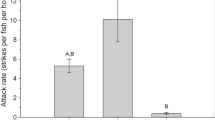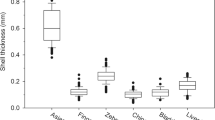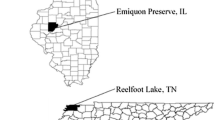Synopsis
In dense, single-species assemblages of crucian carp, competition is intense and results in populations of stunted fish. To explore mechanisms underlying this competition, we measured handling times, return rates, and prey choice for five sizes of crucian carp feeding on six sizes of a standardized food. Handling times increased with prey size and decreased with fish size. Return rates (dry mass ingested per unit handling time) increased dramatically with fish size, and generally decreased with increasing prey size, especially for small fish. Patterns of return rates among size-classes suggested that one or more size-related shifts in feeding efficiency exist for crucian carp; combined with physiological stresses related to winter anoxia, the inability of fish to make these shifts may contribute to size structures observed in high-density populations. Comparisons of relations among fish size, prey size, and return rates for crucian carp and bluegill, Lepomis macrochirus, suggest that similar intraspecific competitive relations exist between generalist species with size-structured populations. Despite differences in return rates among prey sizes, the extent of food selectivity based on prey size exhibited by crucian carp in two types of choice trials was less than predicted. Crucian carp commonly take in several items before mechanically processing food with their pharyngeal apparatus; this multiple prey processing may contribute to disparities between observed choice patterns and those predicted based on return rates for single prey.
Similar content being viewed by others
References cited
Alexander, R.McN. 1967. Functional design in fishes. Hutchinson University Library, London. 160 pp.
Alm, G. 1946. Reasons for the occurrence of stunted fish populations with special reference to perch. Rep. Inst. Freshwater Res. Drottningholm 25: 1–146.
Andersson, G., H. Berggren, G. Cranberg & C. Gelin. 1978. Effects of planktivorous and benthivorous fish on organisms and water chemistry in eutrophic lakes. Hydrobiologia 59: 7–15.
Becker, G.C. 1983. Fishes of Wisconsin. University of Wisconsin Press, Madison. 1052 pp.
Berg, L.S. 1964. Freshwater fishes of the USSR and adjacent countries. Vol. 2. Israel Prog. Sci. Transl., Jerusalem. 496 pp.
Beyerle, G.B. 1971. A study of two northern pike-bluegill populations. Trans. Amer. Fish. Soc. 100: 69–73.
Blaka, B. 1960. On the biology of the crucian carp (Carassius carassius L. morpha humilis Heckel). Zool. Zhurnal 9: 1384–1389.
Casselman, J.M. & H.H. Harvey. 1975. Selective fish mortality resulting from low winter oxygen. Verh. internat. Verein. Limnol. 19: 2418–2429.
Černy, K. 1971. Growth and mortality of crucian carp Carassius carassius (L.) morpha humilis Heckel 1840, in the natural pond Mansfeldova in the Central Elbe Basin. Vest. Česk. sp. Zool. 35: 251–260.
Ciepielewski, W. 1985. Experimentally increased fish stock in the pond type Lake Warniak. Changes of ichthyofauna between 1970 and 1983. Ekol. Pol. 33: 37–59.
Eastman, J.T. 1977. The pharyngeal bones and teeth of catostomid fishes. Amer. Midi. Nat. 97: 68–88.
Elner, R.W. & R.N. Hughes. 1978. Energy maximization in the diet of the shorecrab, Carcinus maenas. J. Anim. Ecol. 47: 103–116.
Galis, F. & P.W. de Jong. 1988. Optimal foraging and ontogeny: food selection by Haplochromis piceatus. Oecologia (Berlin) 75: 175–184.
Gillen, A.L., R.A. Stein & R.F. Carline. 1981. Predation by pellet-reared tiger muskellunge on minnows and bluegills in experimental systems. Trans. Amer. Fish. Soc. 110: 192–209.
Hamrin, S. 1979. Biomass of tench, perch, crucian carp and pike in a small, eutrophic lake in southern Sweden. Jyväs. yliop. biol. lait. tied. 19: 57–67.
Holopainen, I.J. & H. Hyvärinen. 1985. Ecology and physiology of crucian carp [Carassius carassius (L.)] in small Finnish ponds with anoxic conditions in winter. Verb. internat. Verein. Limnol. 22: 2566–2570.
Holopainen, I.J. & A.K. Pitkänen. 1985. Population size and structure of crucian carp (Carassius carassius (L.)) in two small, natural ponds in Eastern Finland. Ann. Zool. Fennici 22: 397–406.
Holopainen, I.J., W.M. Tonn, C.A. Paszkowski & A.K. Pitkänen. 1988. Habitat use, diel activity, and growth of crucian carp in a manipulated pond. Verh. internat. Verein. Limnol. 23 (in press).
Hyvärinen, H., I.J. Holopainen & J. Piironen. 1985. Anaerobic wintering of crucian carp (Carassius carassius L.)—I. Annual dynamics of glycogen reserves in nature. Comp. Biochem. Physiol. 82A: 797–803.
Ivlev, V.S. 1961. Experimental ecology of the feeding of fishes. Yale University Press, New Haven. 302 pp.
Keast, A. 1977a. Mechanisms expanding niche width and minimizing intraspecific competition in two centrarchid fishes. Evol. Biol. 10: 333–395.
Keast, A. 1977b. Diet overlap and feeding relationships between the year classes in the yellow perch (Perca flavescens). Env. Biol. Fish. 2: 53–70.
Krebs, J.R., D.W. Stephens & W.J. Sutherland. 1983. Perspectives in optimal foraging. pp. 165–215. In: A.H. Brush & G.A. Cark (eds.) Perspectives in Ornithology, Cambridge University Press, Cambridge.
Larkin, P.A., J.G. Terpenning & R.R. Parker. 1957. Size as a determinant of growth in rainbow trout Salmo gairdneri. Trans. Amer. Fish. Soc. 86: 84–96.
Liem, K.F. 1973. Evolutionary strategies and morphological innovations: cichlid pharyngeal jaws. Syst. Zool. 22: 425–441.
Magurran, A.E. & T.J. Pitcher. 1983. Foraging timidity and shoal size in minnows and goldfish. Behav. Ecol. Sociobiol. 12: 147–152.
Mittelbach, G.G. 1981. Foraging efficiency and body size: a study of optimal diet and habitat use by bluegills. Ecology 62: 1370–1386.
Moore, F.R. & P.A. Simm. 1985. Migratory disposition and choice of diet by the yellow-rumped warbler (Dendroica coronata). Auk 102: 820–826.
Nikolsky, G.V. 1963. The ecology of fishes. Academic Press, London. 352 pp.
Nikolsky, G.V. & N.G. Shubnikova. 1974. The nature of the interrelationship between abundance and certain biological characteristics in a population of the crucian carp (Carassius carassius). J. Ichthyol. 14: 469–502.
Paszkowski, C.A. 1985. The foraging behavior of the central mudminnow and yellow perch: the influence of foraging site, intraspecific and interspecific competition. Oecologia (Berlin) 66: 271–279.
Persson, L. 1983. Effects of intra- and interspecific competition on dynamics and size structure of a perch Perca fluviatilis and a roach Rutilus rutilus population. Oikos 41: 126–132.
Persson, L. 1986. Effects of reduced interspecific competition on resource utilization in perch (Perca fluviatilis). Ecology 67: 355–364.
Persson, L. 1987. The effect of resource availability and distribution on size class interactions in perch, Perca fluviatilis. Oikos 48: 148–160.
Pitcher, T.J., A.E. Magurran & J.R. Allen. 1986. Size segregative behaviour in minnow shoals. J. Fish Biol. 29 (Supplement A): 83–95.
Pough, F.H. & R.M. Andrews. 1985. Energy costs of subduing and swallowing prey for a lizard. Ecology 66: 1525–1533.
Prejs, A. 1973. Experimentally increased fish stock in the pond type Lake Warniak. IV. Feeding of introduced and autochthonous non-predatory fish. Ekol. Pol. 21: 465–503.
Siegel, S. 1956. Nonparametric statistics for the behavioral sciences. McGraw-Hill, New York. 312 pp.
Sokal, R.R. & F.J. Rohlf. 1981. Biometry. W.H. Freeman & Co., San Francisco. 859 pp.
Stein, R.A., C.G. Goodman & E.A. Marschall. 1984. Using time and energetic measures of cost in estimating prey value for fish predators. Ecology 65: 702–715.
Street, N.E., A.E. Magurran & T.J. Pitcher. 1984. The effects of increasing shoal size on handling time in goldfish, Carassius auratus L. J. Fish. Biol. 25: 561–566.
Tallman, R.F. & J.H. Gee. 1982. Intraspecific resource partitioning in a headwater stream fish, the pearl dace Semotilus margarita (Cyprinidae). Env. Biol. Fish. 7: 243–249.
Thompson, D.J. 1978. Prey size selection by larvae of the damselfly Ischnura elegans (Odonata). J. Anim. Ecol. 47: 769–785.
Tonn, W.M. & C.A. Paszkowski. 1986. Size-limited predation, winterkill, and the organization of Umbra-Perca fish assemblages. Can. J. Fish. Aquat. Sci. 43: 194–202.
Uspenskaja, V.D. 1953. Feeding of crucian carp in lakes of river Kljazma. Trudy Vsesojuzn. Gidrobiol. obšč. 5: 347–364. (In Russian).
Wankowski, J.W.J. 1979. Morphological limitations, prey size selectivity, and growth response of juvenile atlantic salmon, Salmo salar. J. Fish Biol. 14: 89–100.
Wankowski, J.W.J. 1981. Behavioural aspects of predation by juvenile atlantic salmon (Salmo salar L.) on particulate, drifting prey. Anim. Behav. 29: 557–571.
Ware, D.M. 1971. Predation by rainbow trout (Salmo gairdneri): the effects of experience. J. Fish. Res. Board Can. 28: 1847–1852.
Werner, E.E. 1974. The fish size, prey size, handling time relation in several sunfishes and some implications. J. Fish. Res. Board Can. 31: 1531–1536.
Werner, E.E. 1979. Niche partitioning by food size in fish communities. pp. 311–322. In: R.H. Stroud & H. Clepper (eds.) Predator-Prey Systems in Fisheries Management, Sport Fishing Institute, Washington, D.C.
Werner, E.E. & J.F. Gilliam. 1984. The ontogenetic niche and species interactions in size-structured populations. Ann. Rev. Ecol. Syst. 15: 393–426.
Werner, E.E. & D.J. Hall. 1974. Optimal foraging and the size selection of prey by the bluegill sunfish (Lepomis macrochirus). Ecology 55: 1042–1052.
Werner, E.E. & D.J. Hall. 1979. Foraging efficiency and habitat switching in competing sunfishes. Ecology 60: 256–264.
Werner, E.E. & G.G. Mittelbach. 1981. Optimal foraging: field tests of diet choice and habitat switching. Amer. Zool. 21: 813–829.
Werner, E.E., G.G. Mittelbach, D.J. Hall & J.F. Gilliam. 1983. Experimental tests of optimal habitat use in fish: the role of relative habitat profitability. Ecology 64: 1549–1555.
Zahorik, D.M. & K.A. Houpt. 1981. Species differences in feeding strategies, food hazards, and the ability to learn food aversions. pp. 289–310. In: A.C. Kamil & T.D. Sargent (eds.) Foraging Behavior, Garland STPM Press, New York.
Zawisza, J. & W. Ciepielewski. 1973. Experimentally increased fish stock in the pond type Lake Warniak. II. Changes of the autochthonous ichtyofauna due to the introduction of carp (Cyprinus carpio L.) and bream (Abramis brema L.). Ekol. Pol. 21: 423–444.
Author information
Authors and Affiliations
Rights and permissions
About this article
Cite this article
Paszkowski, C.A., Tonn, W.M. & Holopainen, I.J. An experimental study of body size and food size relations in crucian carp, Carassius carassius . Environ Biol Fish 24, 275–286 (1989). https://doi.org/10.1007/BF00001401
Received:
Accepted:
Issue Date:
DOI: https://doi.org/10.1007/BF00001401




